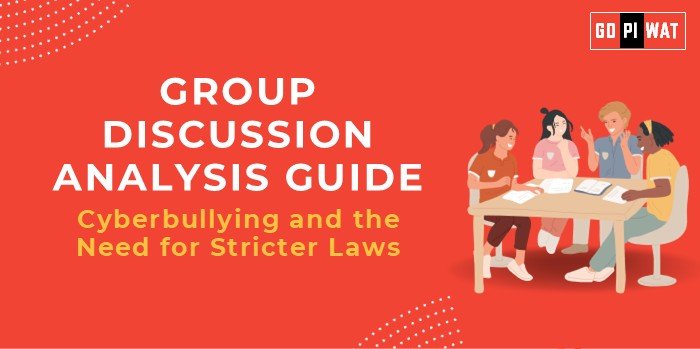📋 Group Discussion (GD) Analysis Guide: Cyberbullying and the Need for Stricter Laws
🌐 Introduction
- 💡 Opening Context: With over 900 million internet users, India has witnessed a surge in cyberbullying cases, affecting individuals’ mental health, privacy, and dignity.
- 📜 Topic Background: Despite existing laws like the IT Act 2000 and IPC Sections 354D (stalking), many argue these measures are insufficient to deter offenders and protect victims in an increasingly digital society.
📊 Quick Facts and Key Statistics
- 📉 Cyberbullying Cases in India (2023): Over 50% of teenagers reported experiencing online harassment.
- 🌐 Social Media Reach: 467 million active users in India create ample ground for misuse.
- 🌍 Global Comparison: Countries like the UK and Australia have stricter cyberbullying laws, with penalties up to 10 years imprisonment.
- 🧠 Mental Health Impact: Studies show cyberbullying victims are twice as likely to experience depression and anxiety.
👥 Stakeholders and Their Roles
- 🏛️ Government: Enacts laws, implements awareness campaigns.
- 📱 Social Media Platforms: Monitor and control abusive content.
- 👩💻 Citizens: Report incidents, promote responsible online behavior.
- 🤝 NGOs: Provide counseling and legal aid to victims.
🏆 Achievements and Challenges
✨ Achievements
- 📢 Increased Reporting: Campaigns like #EndCyberAbuse have encouraged victims to come forward.
- 🛡️ Cyber Cells: Established in most Indian states to address online harassment.
⚠️ Challenges
- 📜 Lack of a Specific Cyberbullying Law: Existing laws are fragmented and insufficient.
- 🎭 Difficulties in Tracing Anonymous Offenders: Tech-savvy culprits evade detection.
- 🏡 Limited Digital Literacy: Rural areas are especially vulnerable due to lack of awareness.
🌍 Global Comparisons
- 🇦🇺 Australia: The “Online Safety Act 2021” empowers victims and enforces platform accountability.
📚 Case Study
- 🎓 Kerala’s Cyber Safety Curriculum: Aims to educate students about online abuse and safety measures.
💬 Structured Arguments for Discussion
- 💪 Supporting Stance: “Stricter laws will deter cyberbullies and safeguard victims’ rights, fostering a safer digital environment.”
- ⚖️ Opposing Stance: “Existing laws, if enforced effectively, are adequate to address the issue; stricter laws may curb freedom of expression.”
- 🤝 Balanced Perspective: “While stricter laws are necessary, education and awareness are equally critical for long-term solutions.”
📚 Effective Discussion Approaches
- 💡 Opening Approaches:
- 📊 “Cyberbullying affects over half of Indian teens, yet current laws offer limited redressal.”
- 🌍 “Countries like Australia have seen reductions in online harassment with strict laws.”
- 🤔 Counter-Argument Handling:
- ⚖️ Rebut Freedom Concerns: “Protecting individuals from abuse is not an infringement but a necessity.”
- 🛠️ Advocate for Tech Monitoring: “Social media algorithms can preemptively filter abusive content.”
🔎 Strategic Analysis of Strengths and Weaknesses
- 💪 Strengths: Strong legal framework potential, public support for stricter measures.
- 🛑 Weaknesses: Lack of enforcement infrastructure, risk of misuse or overreach.
- 🌟 Opportunities: Collaboration with tech companies, education campaigns for youth.
- ⚠️ Threats: Opposition from free-speech advocates, technological barriers in rural areas.
🎓 Connecting with B-School Applications
- 📊 Real-World Applications: Projects on digital ethics, cybersecurity policy frameworks, or tech-based education initiatives.
- ❓ Sample Interview Questions:
- 💡 “How can stricter cyberbullying laws balance protection with free speech?”
- 📱 “Discuss the role of social media platforms in tackling cyberbullying.”
- 📝 Insights for B-School Students: Importance of ethical leadership in tech and policy-making, and understanding social impacts of digital transformations.


